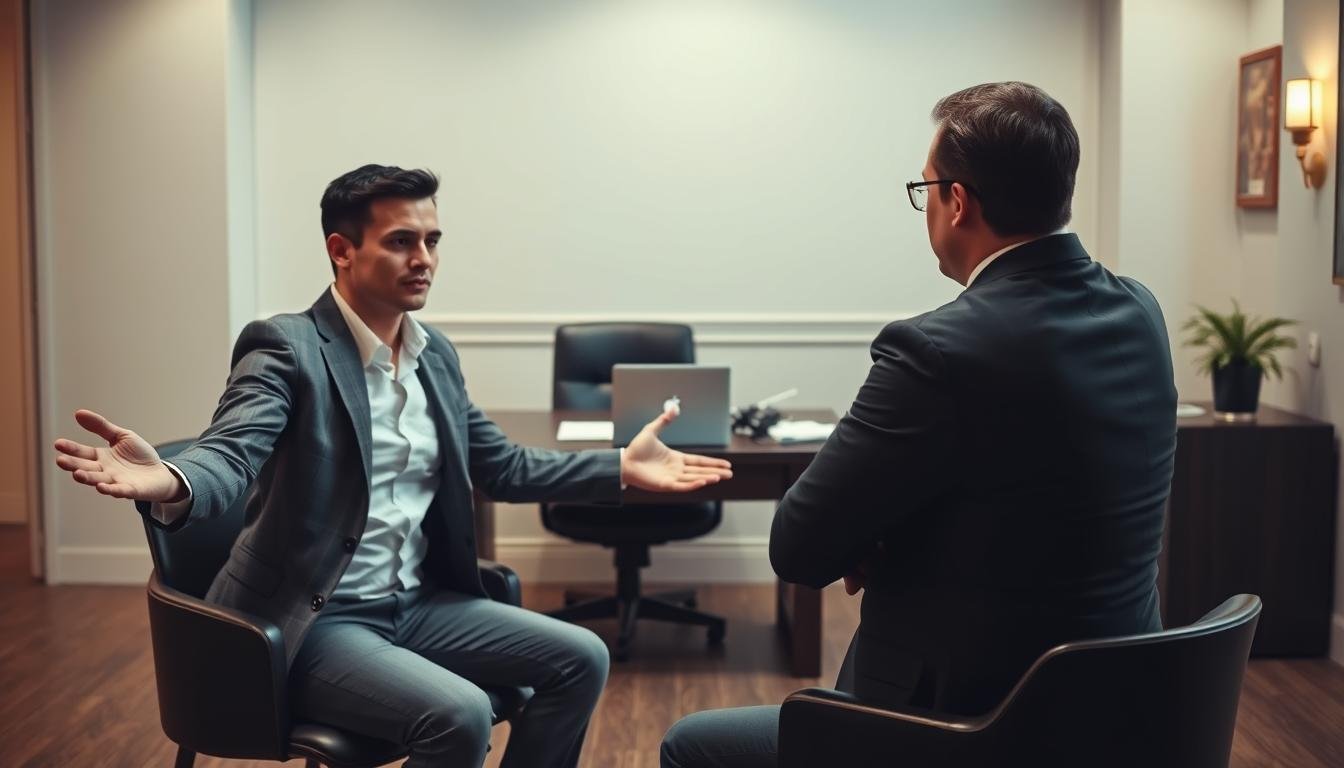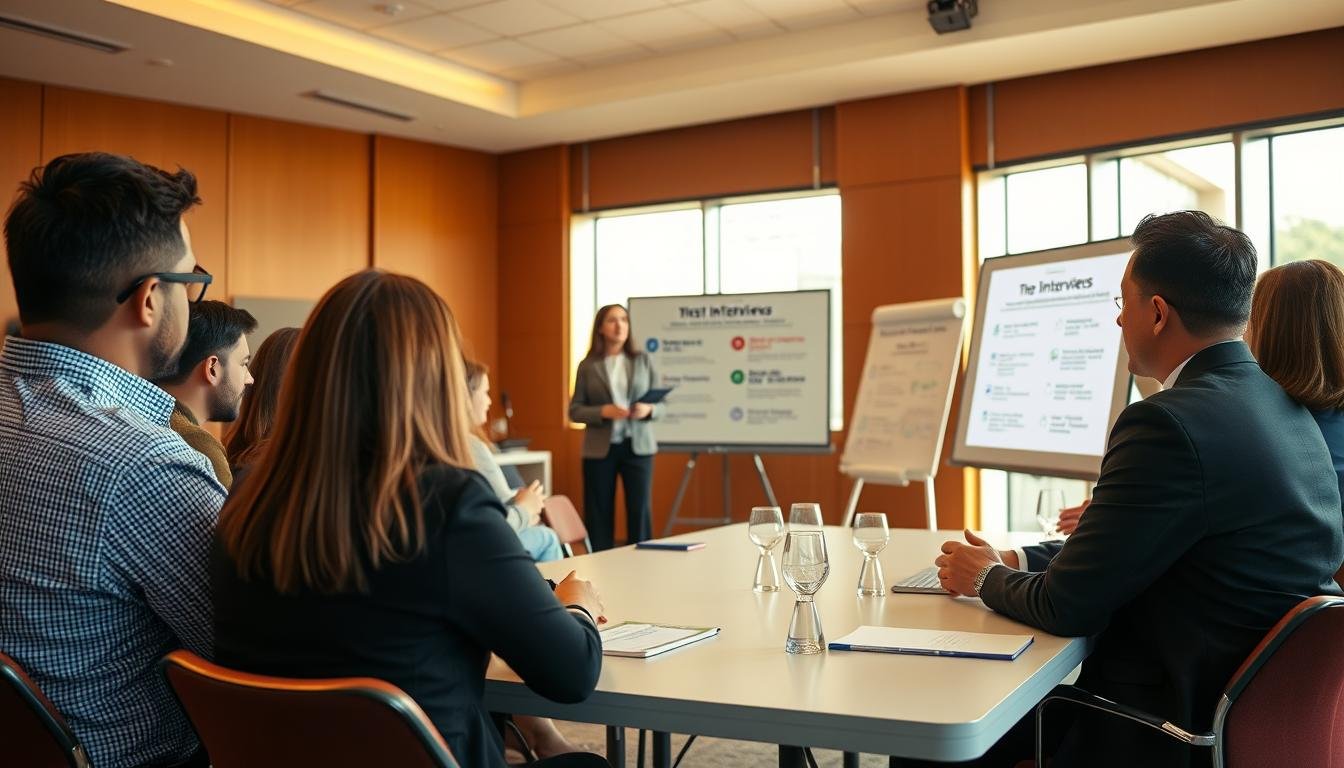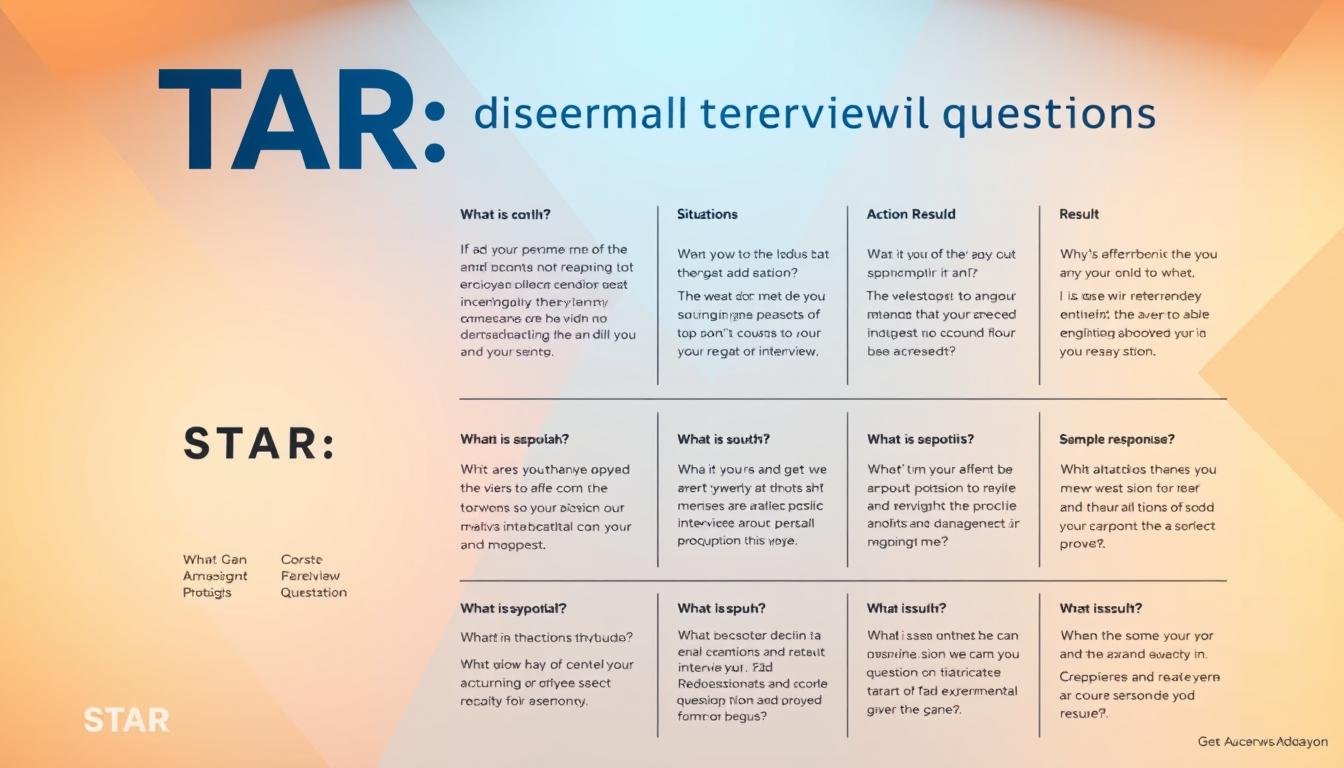Now Reading: Body Language Do’s and Don’ts in Job Interviews
-
01
Body Language Do’s and Don’ts in Job Interviews
Body Language Do’s and Don’ts in Job Interviews

Body Language Do’s and Don’ts in Job Interviews
Did you know your body language can greatly affect your job interview success? In the United States, employers often decide based on how you present yourself. Nonverbal cues are key in making a good impression.

It’s important to keep eye contact and show confidence through your body language. Avoid fidgeting or other behaviors that might distract. Crossing your arms or avoiding eye contact can make you seem uninterested or defensive.
Key Takeaways
- Avoid negative body language cues such as frowning or looking uninterested.
- Use positive nonverbal signals like nodding and smiling to show engagement.
- Maintain a confident and open posture to show interest in the conversation.
- Be mindful of your hand gestures and avoid excessive or distracting movements.
- Make sure your overall demeanor conveys enthusiasm and interest in the position.
The Power of Nonverbal Communication in Interviews
## The Power of Nonverbal Communication in Interviews
Nonverbal cues are key in job interviews. Knowing how to use body language can really help you impress hiring managers.
### Why Body Language Matters to Hiring Managers
Hiring managers often decide based on what they see, not just what they hear. Body language can say a lot about you. Showing confidence, enthusiasm, and professionalism can sway their decision.
### The Science Behind First Impressions
First impressions are made fast and can last. Nonverbal cues like facial expressions and posture are key in making these impressions.
#### The 7-11-55 Rule of Communication
The 7-11-55 rule shows how much nonverbal cues matter. It says 7% of the message is nonverbal, 11% is tone, and 55% is words. This rule shows nonverbal cues are very important.
Being good at nonverbal communication can help you stand out. It can make you seem more confident and professional. This can really help your chances in a job interview.
For example, someone who makes eye contact and smiles can impress more than someone who doesn’t. It’s all about how you present yourself.
By understanding and using nonverbal cues well, you can improve your interview skills. This can help you get hired.
In conclusion, paying attention to your nonverbal communication is crucial in job interviews. Being aware of body language and using it right can make a big difference. It can help you impress hiring managers and increase your chances of getting hired.
Professional Posture: Do’s and Don’ts
Professional posture is crucial in job interviews. It shows confidence and respect. It’s important for both the interviewer and the candidate.
Posture Do’s: Sitting and Standing with Confidence
When sitting, keep your back straight and avoid slouching. Place your feet flat on the floor or cross them at the ankles. Confident sitting posture means keeping your shoulders back and head up.
The “Power Pose” Technique
The “Power Pose” technique boosts confidence. Stand tall with feet shoulder-width apart and hands on hips. It changes how you feel and look to others.
Posture Don’ts: Slouching and Fidgeting
Slouching and fidgeting show a lack of confidence. Avoid leaning forward too much or tilting your head too far. It can make you seem too eager or lacking confidence.
Video Analysis: Effective vs. Ineffective Posture
| Posture Type | Characteristics | Impact on Interview |
|---|---|---|
| Effective Posture | Straight back, shoulders back, head held high | Conveys confidence and respect |
| Ineffective Posture | Slouching, fidgeting, leaning forward excessively | May convey lack of confidence or interest |
Practicing good posture in job interview practice or role play interviews helps. It makes you more aware of your body language. This can improve your confidence and performance.
Eye Contact Mastery
Eye contact is key in job interviews. It shows confidence and sincerity. It helps build a connection with the interviewer and can change the interview’s outcome.
Eye Contact Do’s: Building Connection and Trust
Good eye contact in an interview shows confidence and builds trust. Aim for eye contact 70-80% of the time. Direct eye contact means you’re fully engaged.
- Look at the interviewer’s eyes or the area between their eyebrows.
- Occasionally glance away to process information or to avoid staring.
Eye Contact Don’ts: Staring and Avoidance
Avoid aggressive staring or not making eye contact. Staring can be seen as confrontational. Not making eye contact may suggest lack of confidence or dishonesty.
- Refrain from staring intensely, as it can make the interviewer uncomfortable.
- Avoid looking away too frequently, as it may indicate a lack of interest.
Cultural Considerations for Eye Contact
Knowing about cultural differences in eye contact is crucial. In some cultures, direct eye contact is a sign of respect. In others, it’s seen as aggressive.
| Culture | Eye Contact Norms |
|---|---|
| Western Cultures | Direct eye contact is generally seen as a sign of confidence and respect. |
| Some Asian Cultures | Avoiding direct eye contact can be a sign of respect, especially towards elders or authority figures. |
Video Analysis: Optimal Eye Contact Techniques
These videos show effective eye contact strategies. You can improve these skills through interview preparation workshops or job interview coaching.
Hand Gestures That Enhance Your Message
How you use your hands when speaking can greatly affect how your message is seen in an interview. Hand gestures show confidence, enthusiasm, and honesty. This makes your words more powerful.
Purposeful Movement
Using hand gestures wisely can make your message stronger and grab the interviewer’s attention. Effective hand gestures include:
- Open palm gestures to show honesty and openness
- Emphatic gestures to highlight important points
- Illustrative gestures to explain complex ideas clearly
Distracting Habits
Stay away from hand habits that distract, like fidgeting or waving too much. These can hurt your message and leave a bad impression.
Managing Nervous Hand Movements
To control nervous hand movements, try relaxation techniques like deep breathing. During the interview, use your hands for meaningful gestures or keep them still on your lap or the table.
Video Analysis: Effective Hand Gesture Examples
Watching videos of good hand gestures in interviews can teach you a lot. See how confident speakers use gestures to improve their communication. Try a workshop practicing job interviews to practice and get feedback on your gestures. It’s part of effective interviewing techniques.
Facial Expressions That Convey Enthusiasm
Showing enthusiasm through facial expressions can make a big difference in a job interview. Facial expressions play a key role in nonverbal communication. They greatly affect how interviewers see a candidate’s interest and engagement.
Facial Expression Do’s: Authentic Engagement
To show genuine interest and enthusiasm, candidates should aim for these:
- Maintain a relaxed and friendly look
- Smile naturally when it’s the right time
- Show interest with raised eyebrows or slight nods
These small signs can really boost how enthusiastic and engaged a candidate seems.
Facial Expression Don’ts: Negative Microexpressions
It’s important to avoid negative microexpressions. They can harm a candidate’s impression. Common mistakes include:
- Frowning or looking disapproving
- Showing boredom or disinterest
- Looking anxious or stressed with tense facial muscles
Knowing about these negative signs can help candidates work on improving.
Video Analysis: Reading and Controlling Facial Cues
Looking at video recordings of job interviews can offer great insights. By watching these videos, candidates can spot areas to get better at. This includes controlling negative signs or showing more genuine interest. This self-check is a great way to improve interview skills.
By getting better at facial expressions that show enthusiasm, candidates can do much better in interviews. This can really help them succeed.
Voice and Speech Patterns
Effective voice and speech patterns are key to making a good impression in job interviews. How you speak can greatly affect how you’re seen by the interviewer.

Voice Do’s: Clarity, Pace, and Tone
To make a strong impression, focus on clarity, pace, and tone. Speak clearly by saying your words well, don’t rush, and use a tone that shows you’re excited and interested. Practicing with mock interviews or role-play interviews can help you get better at these skills.
Voice Don’ts: Filler Words and Uptalk
Avoid using filler words like “um” and “ah,” as they can make you seem less confident. Also, watch out for uptalk, which sounds like you’re asking a question at the end of a sentence. Knowing these habits is the first step to changing them.
Breathing Techniques for Voice Control
Proper breathing techniques can help you control your voice. This ensures you speak at a good pace and with confidence. Deep breathing exercises before an interview can help calm your nerves and make your voice sound better.
Video Analysis: Effective Speaking Patterns
Watching videos of successful interviews can give you insights into good speaking patterns. Look at how these people use their voice to show confidence and enthusiasm. You can use these tips to improve your own interview skills, practicing in front of a mirror or recording yourself to see what you can do better.
Workshop Practicing Job Interviews: Body Language Drills
Workshops help you improve your body language for job interviews. You’ll learn through self-assessment, role-play, and video analysis.
These workshops are great for improving your body language and interview skills. They include drills and exercises to boost your nonverbal communication.
Mirror Technique for Self-Assessment
The mirror technique is a key method in these workshops. It lets you observe yourself in a mock interview. This way, you can notice your nonverbal cues like eye contact and posture.
It helps you see what you need to work on. You can then adjust to look more professional and confident in real interviews.
Role-Play Exercises with Feedback
Role-play exercises are a big part of these workshops. You’ll take turns being the interviewer and the candidate. This helps you practice answers and improve your body language.
Feedback from others is crucial. It tells you what you’re doing well and what you can improve. This feedback is key to getting better at nonverbal communication.
Video Recording Analysis Methods
Video analysis is a powerful tool in these workshops. It lets you review your mock interviews and check your body language.
By looking at your posture and facial expressions, you can make targeted improvements. This helps you get better at nonverbal communication.
Creating a Personal Body Language Improvement Plan
After these exercises, you can make a personalized improvement plan. This plan will have strategies for better body language, like confident posture and eye contact.
By sticking to this plan, you can improve your nonverbal skills. This will help you do better in real job interviews.
Virtual Interview Body Language Strategies
In today’s digital world, virtual interviews are more common. It’s key to know how to use body language in these interviews. We’ll cover what to do and what to avoid to improve your digital presence and ace your next virtual interview.
Virtual Do’s: Digital Presence Optimization
To improve your digital presence in virtual interviews, follow these tips:
- Make sure your video quality is high and steady. Poor quality can hurt how you’re seen by the interviewer.
- Look into the camera as if you were in person. But don’t stare too long, as it can seem aggressive.
- Use gestures and body language that show confidence and excitement. Try not to fidget or show distracting habits.
- Pay attention to your posture and where you sit or stand. A clean and organized digital space can also make a good impression.
Virtual Don’ts: Common Remote Interview Mistakes
Avoid these common mistakes in virtual interviews:
- Don’t be too casual or too formal. It can make you seem unprofessional or hard to approach.
- Try not to use filler words like “um” or “ah” too much. They can make you seem less confident.
- Even if you’re not there in person, dress professionally. Your clothes can still be seen through your digital presence.
Technical Setup for Optimal Body Language
To improve your virtual interview body language, focus on these technical details:
- Make sure your audio is clear and sharp. Avoid background noise and echo, as they can be distracting.
- Use a good webcam with proper lighting. Avoid too bright or too dim light, as it can hide your facial expressions.
- Consider wearing a headset or earphones to reduce echo and ensure your voice is heard clearly.
Video Analysis: Effective Virtual Interview Examples
Let’s look at some examples of good virtual interview body language:
- A candidate who keeps eye contact, uses gestures, and shows confidence will likely impress more.
- On the other hand, avoid those who fidget a lot or use too many filler words. It can make a bad impression.
Industry-Specific Body Language Adjustments
Corporate vs. Creative Field Differences
Customer-Facing vs. Technical Role Considerations
Researching Company Culture for Body Language Cues
Your body language matters a lot in a job interview. It can greatly affect how you’re seen by the interviewer. Different jobs and industries need different ways of showing what you mean without words.
Understanding these differences and adjusting your body language can really help. It can make you stand out in a good way and help you get the job you want.
Overcoming Body Language Anxiety
Anxiety about body language can really hold you back in job interviews. But, there are ways to beat it. People often worry about how others see their nonverbal signals. This can make them feel less confident and less ready.
Pre-Interview Relaxation Techniques
Getting ready before the interview is key. Try deep breathing exercises and progressive muscle relaxation to calm down. Doing mock interviews or role-play interviews with someone you know can also boost your confidence.
Grounding Methods During Interviews
During the interview, use grounding techniques to stay calm. Focus on the now, like feeling your feet on the floor or your hands on the armrest. Also, take a second to collect your thoughts before answering. This can help you avoid nervous habits.
Recovery Strategies When Mistakes Happen
Mistakes can still happen, even with good prep. The important thing is to bounce back well. A brief acknowledgment of the mistake followed by moving on is a smart move. Getting job interview coaching can help you master this.
Cognitive Reframing for Confidence
Changing how you think about the interview can help a lot. Instead of seeing it as stressful, view it as a chance to show off your abilities. This positive mindset can greatly reduce your anxiety and improve your body language.

Conclusion: Integrating Body Language Into Your Interview Strategy
Mastering body language is key to acing job interviews. Using effective nonverbal cues can greatly improve your chances of making a good impression. An interview preparation workshop can offer valuable insights and practical tips on body language.
Good interviewing involves both what you say and how you act. Practicing these skills in a workshop can boost your confidence and clarity. This makes you more ready for the real interview.
By focusing on body language, you can show enthusiasm, build trust, and appear confident. This complete approach to interview prep can lead to more job success.
FAQ
What are some common body language mistakes to avoid in job interviews?
Avoid slouching, fidgeting, and not making eye contact. Also, try not to use distracting hand gestures. Training and mock interviews can help you improve.
How can I improve my nonverbal cues during an interview?
Practice good interviewing skills. Keep a professional posture and make eye contact. Use hand gestures wisely. Role-play and workshops can help.
What is the significance of the 7-11-55 Rule in communication?
The 7-11-55 Rule shows that most communication is nonverbal. 7% is words, 11% is tone, and 55% is body language. This makes body language very important.
How can I practice and improve my body language for job interviews?
Practice with mock interviews, in-person or online. Use the mirror technique and video recording to assess yourself. Create a plan to improve your body language.
Are there industry-specific body language adjustments I should be aware of?
Yes, different fields need different body language. Corporate settings are formal, while creative ones are more relaxed. Knowing the company culture helps.
How can I manage body language anxiety during interviews?
Use relaxation techniques before the interview. Ground yourself during it. Have strategies for when you make mistakes. Building confidence helps too.
What are some effective strategies for virtual interview body language?
Make a good digital impression. Avoid remote interview mistakes. Ensure your tech is ready. Practice and watch video examples to get better.






























